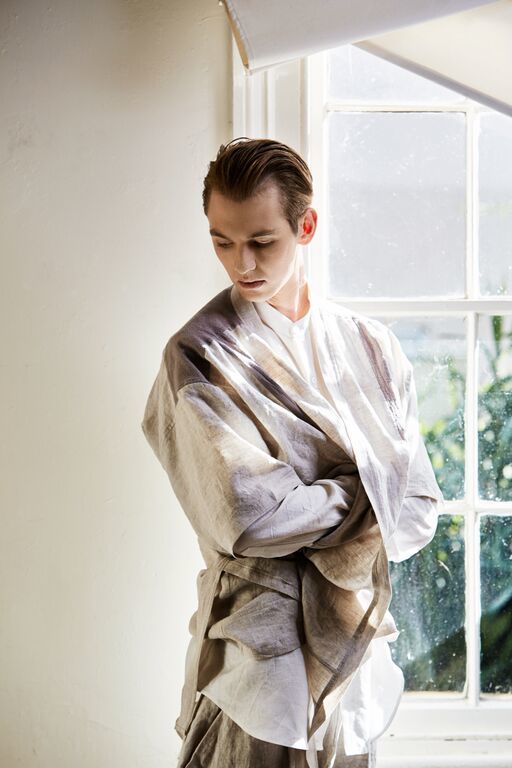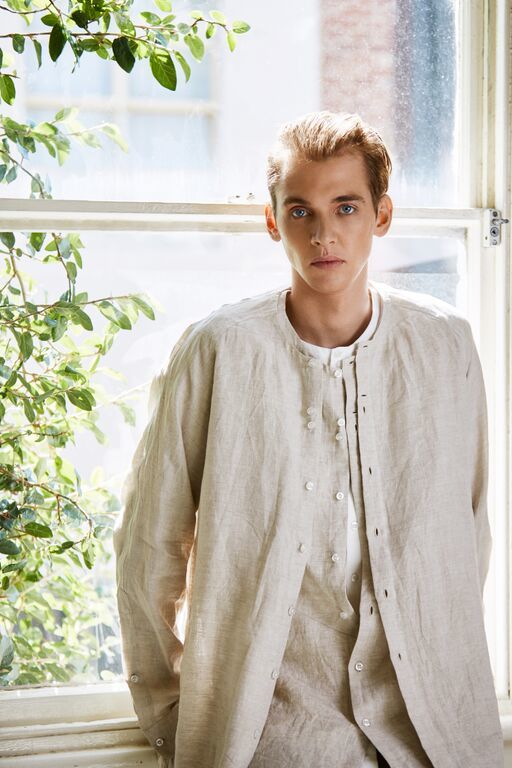Warren Harrison, the face behind men’s label Scott Benedictine, isn’t in a rush. Speaking to him in a noisy cafe, his quiet presence seems to slow the actions spinning around him. It’s easy to rest your chin in your palm and forget if you were meant to be somewhere when he talks about his time working as a tailor and his decision to go it alone.
His label is an extension of his commitment to take life at the right pace. Launched in 2012, it was years until any of his signature minimalist, and oddly naturalistic designs were available for purchase. During that time they existed solely in editorials, or on the Instagrams of friends who were lucky enough to be gifted a piece. They’d appear—always a just-right pair of pants, jacket, or tee—but be tantalisingly unavailable.
Although Warren insists his resistance to actually sell his product was born out of a seemingly endless quest for perfection, it conveniently made the label desired before it fully launched. Now finally up and running, Scott Benedictine’s slow burn feels right, and like Warren, exactly where it’s supposed to be.

Your timeline is tricky, how long have you been doing Scott Benedictine?
This label has just been a concept for a long time while I was working for a tailor. I had a little launch in 2012, but that was just to create some enthusiasm and say, I’m doing something! That was good, but nothing was made available for sale. So the entire site, any photo shoot we did, or anytime I collaborated with somebody, it was purely on an aesthetic level.
Why wait so long to make it available?
Because I’m a creative perfectionist I guess. I didn’t want to release anything because I wanted to continue to build it and the idea behind it. I guess the time came about, or was sort of forced upon me, when the tailor house I worked for closed down last year.
I’d been working for other people for such a long time, and working with their concepts and ideas. Tailoring is such a succinct skill, it has boundaries.
When you were in that loop of insisting it had to be perfect, did you worry you’d never reach your own expectations and never get anything
out?
Oh yeah, that’s the creative basis right? You always want everything to be better, and on top of that you think that you’re past everything you’ve done because you’re always looking forward. You do a huge amount of work because you need to progress, you need to catch up with your ideas, or where you’ve intended to take it. It’s the constant pursuit of perfection.
Did that obsession come from doing something as succinct as tailoring, or was it part of your personality that drew you to sewing?
I honestly never really liked tailoring. I never really liked suits.

Really? But you worked as a tailor for so long, and were so good at it.
I wanted to learn it. I respect the craft and the heritage in the craft. But, this could get me into trouble, I don’t like suits at all.
I suppose your work now is kind of the opposite of suiting.
Yeah, getting into tailoring was a means of learning the skill set that everyone at the highest of their game says they have. It’s like being an architect. It was the craft I wanted more than the suiting.
At the moment it feels like so many designers are coming to fashion from styling, art direction, and other parts of design rather than traditional sewing backgrounds. Do you think you need to understand how to sew to be able to design?
I think so. I think you need to understand it. There are so many people who are doing so well because they understand good creative direction, and have good organisational delegation skills and can understand how to build something.
But that doesn’t necessarily mean that they understand the quality behind it. Being able to do it from start to finish is something our generation forgets I think.

When we look at Australian fashion in 10 years, do you think that move away from sewing will be reflected in the national aesthetic?
I would love to hope that there’s a return to sewing. That said, in 10 years time, who knows? There are already companies doing 3D scales and printing to people’s bodies. Sometimes I fear I’ve chosen a craft that will be outdated at some stage. And maybe what I do will be obsolete because you’ll just be able to print any kind of garment that fits anyone perfectly.
But I like the personal aspect, and I hope that’s where we go. We’ve done that in so many other areas—art, food, cafe culture—everything is driven towards bringing people together and getting them excited. I’d like to see that with fashion a little bit more. I hope it goes in that direction, but who knows.
Where do you want to be in 10 years?
I just want to be happy and content. That’s such a Miss Teen America answer. I’d like to make a living doing what I love, and be allowed room to continue to progress doing what I’m doing. Just, happy.
Credits
Text Wendy Syfret
Lede photo by Teva Cosic
Photography Brett Walker
Hair and make up Olivia Still
Model Jarrah @ Scene Model Management
